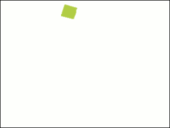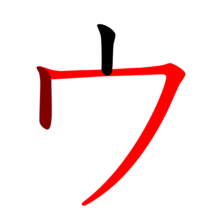U (kana)
| Hiragana | Katakana | ||||||||||||||||||||||||||||||||||||||||||||||||||||||||||||||||||||||||
|---|---|---|---|---|---|---|---|---|---|---|---|---|---|---|---|---|---|---|---|---|---|---|---|---|---|---|---|---|---|---|---|---|---|---|---|---|---|---|---|---|---|---|---|---|---|---|---|---|---|---|---|---|---|---|---|---|---|---|---|---|---|---|---|---|---|---|---|---|---|---|---|---|---|

|

|
||||||||||||||||||||||||||||||||||||||||||||||||||||||||||||||||||||||||
| Stroke order | |||||||||||||||||||||||||||||||||||||||||||||||||||||||||||||||||||||||||
|
|
|
||||||||||||||||||||||||||||||||||||||||||||||||||||||||||||||||||||||||
| Unicode | |||||||||||||||||||||||||||||||||||||||||||||||||||||||||||||||||||||||||
| U + 3046 | U + 30A6 | ||||||||||||||||||||||||||||||||||||||||||||||||||||||||||||||||||||||||
| origin | |||||||||||||||||||||||||||||||||||||||||||||||||||||||||||||||||||||||||
| 宇 | 宇 | ||||||||||||||||||||||||||||||||||||||||||||||||||||||||||||||||||||||||
| Transliteration | |||||||||||||||||||||||||||||||||||||||||||||||||||||||||||||||||||||||||
| Kunrei : | u | ||||||||||||||||||||||||||||||||||||||||||||||||||||||||||||||||||||||||
| Hepburn : | u | ||||||||||||||||||||||||||||||||||||||||||||||||||||||||||||||||||||||||
| 50 sounds board | |||||||||||||||||||||||||||||||||||||||||||||||||||||||||||||||||||||||||
|
|||||||||||||||||||||||||||||||||||||||||||||||||||||||||||||||||||||||||
う in Hiragana orウ in Katakana ( romanized u ) is one of the Japanese Kana which represents a Mora . Itranks third inmodern Japanese alphabetical sorting . It is also the 24th letter in the Iroha , immediately after theむ and before theゐ . In the Gojūon table (sorted by columns from left to right) う is in the first column (あ 行 , a-gyō , "Column A") and in the third row (う 段 , u-dan , "Row U" ). Both sounds represent [ u͍ ].
| shape | Rōmaji | Hiragana | Katakana |
|---|---|---|---|
| Normal a / i / u / e / o ( あ 行 a-gyō ) |
u | う | ウ |
|
uu ū |
う う , う ぅ う ー |
ウ ウ , ウ ゥ ウ ー |
For the combination う ぅ or ウ ゥ there is no uniform regulation in the Hepburn system, according to the variant Hyōjun-shiki in the 1974 version, this is transcribed as wu .
| other forms | |||||||||||||||||||||||||||||||||||||
|---|---|---|---|---|---|---|---|---|---|---|---|---|---|---|---|---|---|---|---|---|---|---|---|---|---|---|---|---|---|---|---|---|---|---|---|---|---|
|
|
||||||||||||||||||||||||||||||||||||
The hiragana variant of Dakuten ゔ is almost never used because the sound does not appear in original Japanese.
Derivation
Both forms う and ウ are derived from the Kanji 宇 via Man'yōgana (pronounced u with the meaning space ).
variants
The scaled down versions of the characters ( ぅ , ゥ ) are used to create mores that do not appear in the Japanese language, for example ト ゥ (tu). This form of application is relatively new. For example, in the phrase Tutankhamun's cartouche , the newer loanword cartouche uses the new phonetic form. In the older word Tutankhamun , ツ (tsu) is used as an approximation:
The character う is also used in its normal form to lengthen the tone o , for example in the word 構想 , written in hiragana こ う そ う (kousou), pronounced kōsō . In some words, the character お (o) is used as an extension . There are morphological or historical reasons for this.
The kana ウ written with Dakuten ヴ (vu) is used to represent a phone foreign to Japanese, and is usually approximated with ブ (bu) to represent the sound.
Stroke order
The hiragana う is drawn with two lines :
- At the top is a short diagonal hook, first swung to the right and then in the opposite direction to end just below the beginning.
- Continued after a gap, a large curved line, initially diagonally slightly to the top right, then ending in a wide arc to the bottom left.
The katakana ウ is written with three lines.
- At the top, a short vertical line pointing downwards.
- The same line, but on the left edge and in height below the first line.
- At the top of the second line, make a straight line to the right through the bottom of the first line. Then led in a wide curve down to the left. Apart from the short verticals, this katakana is identical to the フ .
Other forms of representation
- In Japanese Braille :
- The Wabun code is ・ ・ -
- In the Japanese spelling table , it is spelled as 上 野 の ウ ( Ueno no U ).
Web links
Individual evidence
- ↑ 海 津 知 緒 : 標準 式 ロ ー マ 字 つ づ り - 引用 . (No longer available online.) December 6, 2003, archived from the original on September 24, 2015 ; Retrieved October 27, 2013 (Japanese). Info: The archive link was inserted automatically and has not yet been checked. Please check the original and archive link according to the instructions and then remove this notice.




